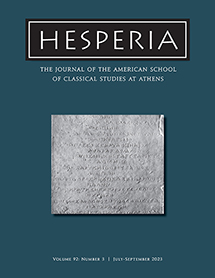Hesperia 92.3 Now Online!

We are pleased to announce the publication of Hesperia 92.3! Topics in this issue include Keian pottery and Late Bronze Age chronology, a look at the demography of Hellenistic Boiotia, an examination of a Panathenaic victor list, and a study on the chemical composition of domestic wares at Corinth.
Subscribers can read the issue online at Project MUSE, which now hosts current issues of Hesperia as well as an archive of past volumes dating to 2002. Hesperia remains on JSTOR as part of their Arts and Sciences II package, with the usual three-year moving wall. Additionally, all issues of Hesperia from 2011 and earlier are available as Open Access on our website. The printed version will be mailed shortly.
In Sync: Keian Insights on Pottery Chronologies at the Transition to the Late Bronze Age, by Natalie Abell, acknowledges how synchronizing cultural changes between Aegean regions at the transition to the Late Bronze Age has proven difficult. In this regard, Ayia Irini on Kea proves to be a key site for addressing chronological questions, owing to its stratified deposits and common pottery imports and imitations. Previous studies have suggested that ceramics from the first part of the Late Bronze Age (period VI) can be divided into an early and late phase, but the defining features of the earlier phase have not been discussed in detail. This article characterizes the ceramics of the early phase of period VI and provides a new review of synchronisms.
Counting Boiotians: Conscription Lists, Military Forces, and Demography in Hellenistic Boiotia, by Thierry Lucas and Guillaume Dubach, presents a new attempt to estimate the size of the army and the population of Boiotia in the Hellenistic period. The calculation is based on an important type of epigraphic evidence in the region: conscription lists from the various cities of the Boiotian Confederacy, following a method initiated by Beloch. Confidence intervals are provided to estimate the age class of 20 in each city as well as whole districts where reliable data are available, and the population model is subsequently drawn from the work of contemporary statisticians. The authors determine a military potential of 11,000–14,500 men aged 20–49, which equates to a citizen population (including women and children) of 59,000–78,000 and to a total population of 75,000–115,000.
A New Edition of the List of Panathenaic Victors IG II2 2313, by Stephen V. Tracy, provides a new edition of the Panathenaic victor list IG II2 2313, the first to be made based on autopsy of the stone as well as photographs and squeezes of it, and suggests a date for it in the years just prior to the Second Macedonian War. Such examination places this important text in the context of the games and demonstrates that it forms part of a connected series of Panathenaic victor lists of the late 3rd and first half of the 2nd centuries B.C. This stone preserves portions of three lists, which have fewer events and a markedly different organization from later lists. These early lists thus reflect a period of transition in the reestablishment of the games after the recovery of independence in 229 B.C.
Local Utilitarian Pottery at Ancient Corinth: Differences in Materials and Diachronic Changes, by David Adan-Bayewitz, Kathleen Warner Slane, and Frank Asaro, explores the chemical-element composition of a wide range of local domestic wares (late 6th century B.C. to early 4th century A.D.). Using instrumental neutron activation analysis and two statistical approaches, we examine whether function or date explains variations in the chemical groups we found and if they match their archaeological labels. The initial choice of ceramic pastes (cooking fabric or buff ware) relates to function, but within those main categories, vessel function did not affect grouping. Fabrics did vary with time. Such changes do not occur at the same time in the cooking and buff wares, nor do they correlate well with the political history of the city.
Click here to subscribe to Hesperia. In addition to receiving printed issues and online access to Hesperia, subscribers also receive complimentary online access to Hesperia Supplements, and Agora and Corinth volumes.
Hesperia welcomes submissions from scholars working on all aspects of Greek material culture, including archaeology, art, architecture, history, epigraphy, and related studies. Further information about the journal, including instructions for preparing manuscripts for submission, can be found on our website.
The Friends of Hesperia was founded in 2014 to help fund the journal's growth in all its manifestations. We invite you to become a member today and help support one of the most preeminent journals in the field of Mediterranean archaeology.